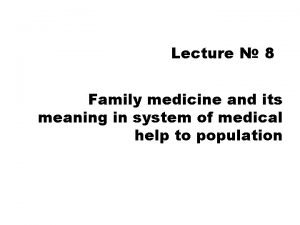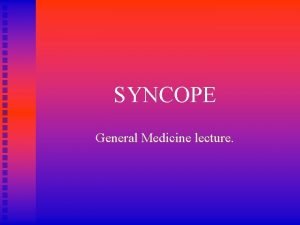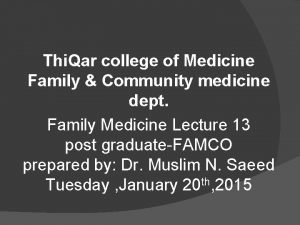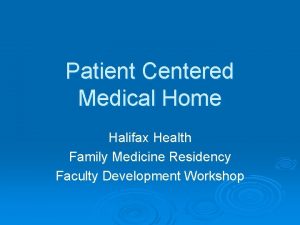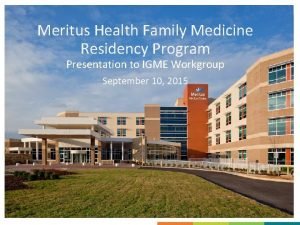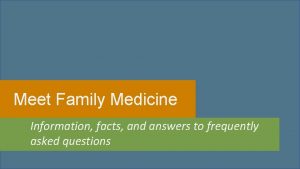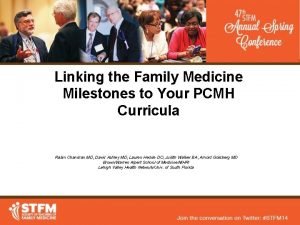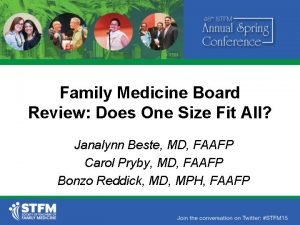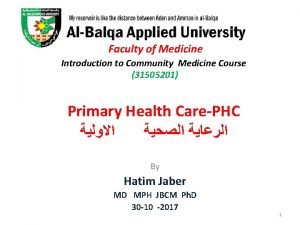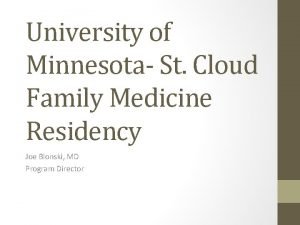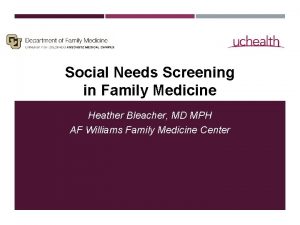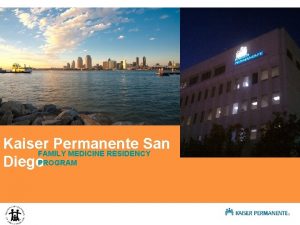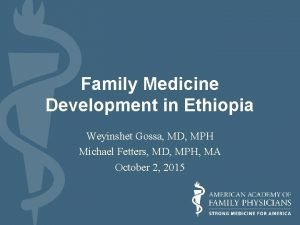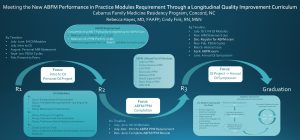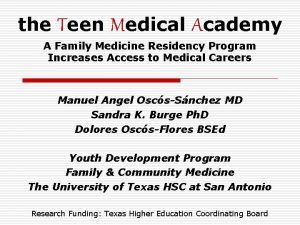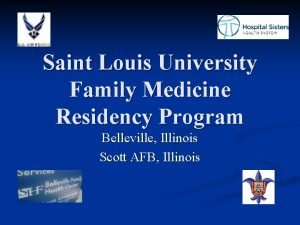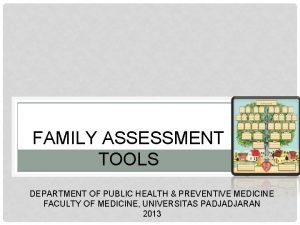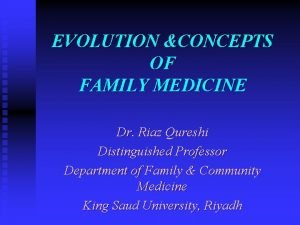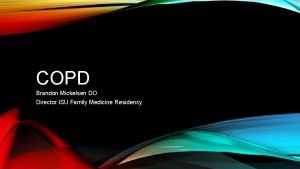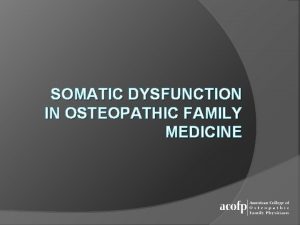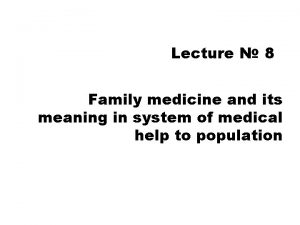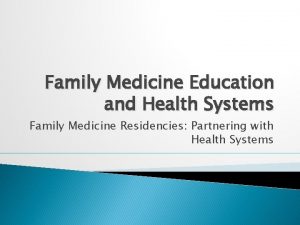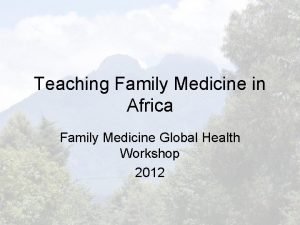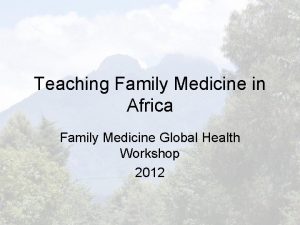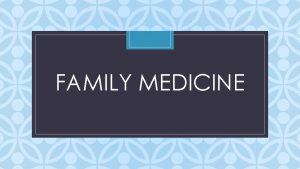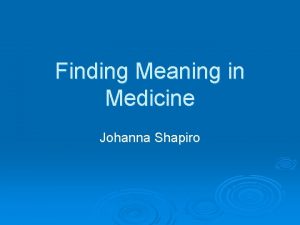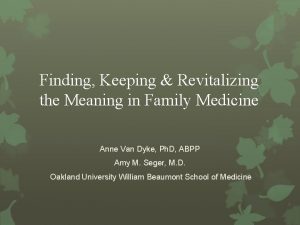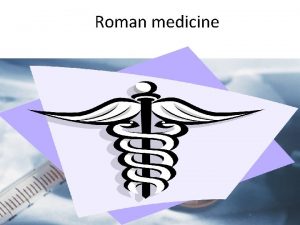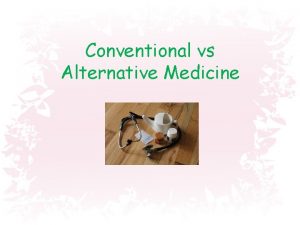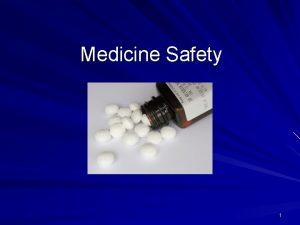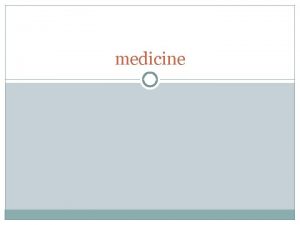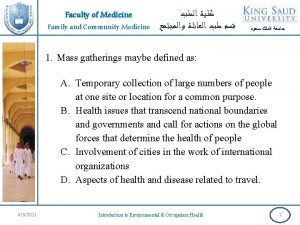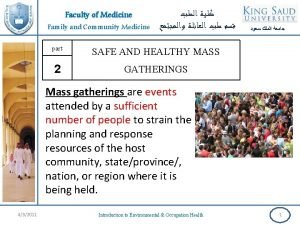Lecture 8 Family medicine and its meaning in

























- Slides: 25

Lecture № 8 Family medicine and its meaning in system of medical help to population

The History of Family Practice The Term General Practitioner (GP) came into use at about the beginning of the 19 th century Before that: Physicians Surgeons Apothecaries In the beginning of the 20 th century the over helming majority of all physicians were Gps

The History of Family Practice 1908 – 1910 Flexner study and report about the medical schools in USA and Canada --- shift towards specialization and subspecialization --- decrease no of Gps. Then the problem of the decreasing number of Gps and its implications started to be recognized. --- many medical leaders asked for decreasing specialty residences and increasing residencies in general practice.

The History of Family Practice In 1947 foundation of the American Academy of General Practice. First training program of General Practice in USA started in 1950. In England the Royal College of General Practitioner was founded in 1952. And then the vocational training for General Practitioners started.

The Birth of Family Medicine In 1969 the American Boards approved Family Practice as a new Specialty In 1970 the ABFP offered the first certification exam and mandated re-certification every 7 years In 1971 the AAGP became the AAFP

Growth of Family Medicine grew and flourished through the 70 s, 80 s and mid-90 s Residencies grew and diplomates increased The Society of Teachers of Family Medicine was established in 1968 to promote the specialty The ABFP is now the second largest board The specialty has the largest delegation to the American Medical Association

Definition Family medicine is an accumulated body of knowledge dealing with the health, the state of total well being, of an individual within the family unit. Family practice is a specialty that provides continuous and comprehensive health care – without limitation by age, sex, organ system, or disease entity – in relation to the family unit. The family physician is the practitioner who implements the principles of the discipline of family medicine in the specialty family practice.

The aim of family medicine According to the World Organization of Family Doctors (Wonca), the aim of family medicine is to provide personal, comprehensive and continuing care for the individual in the context of the family and the community. The issues of values underlying this practice are usually known as primary care ethics.

Who is a Family Physician? Family physicians possess unique attitudes, skills, and knowledge which qualify them to provide continuing and comprehensive medical care, health maintenance and preventive services to each member of the family regardless of sex, age or type of problem, be it biological, behavioral, or social

What is the Contribution of Family Practice According to National Data Sets? FP contribution from different perspectives: 1. Annual number of visits to Family Physicians 2. Proportion of visits to FP/GP for selected problems 3. Number of visits to Family Physicians for the top eight Priority Health Conditions 4. Distribution of Family Physicians in rural areas 5. Contribution of FP across the nation as a function of Primary Care Health Personnel Shortage Areas

Family Medicine and Rural Settings In 1997, the proportion of non-Federal, allopathic, primary care practicing in non-MSA, rural setting was: Family Practice 21% General Internists 8% General Pediatricians 7%

The Doctor-Patient Relationship is being constantly eroded Family Medicine is based on its ability to create long term relationships of trust and partnership between doctors and patients Continuity is based on time commitment

The Boundaries of the Specialty Eroding Away? The Scope of Family Medicine is Shrinking ◦Internal Pressures Issues of Competency ◦External Pressures: Economic forces Mandatory Hospitalists Unfavorable reimbursement for procedures performed by Family Physicians

• • • In forming the state policy in the sphere of public health several facts were of the greatest significance, they were: realization of World Health Organization Strategy “Health-21” (1998) and “Baselines of Policy in Achieving Health for Every body in the European Region (2000). The decree of the Ukrainian President “On the concept of public health development for the population of Ukraine” and the Cabinet of Ministers resolution “On complex measures in family medicine within the system of public health”.

Thus, today the development of the status of a family doctor has become a task of the state level and the main direction of local authorities actions and those of local public health workers. the modern stage of the reform in medical aid services for the population has its task to use effectively and economically the public health resources, improve access to medical services and to increase the quality of these services.

The main principles of reforming are: • family orientation, • ensuring continuity of medical help from birth and through the life span, • prevention in forming, keeping up and improving the health of every family member, • concern about social, economic, ecological, genetic psychological and other factors’ influence on patients.

Standard documents: ü Orders of the Ministry of Health of Ukraine, ü Regulations about doctors and nurses of general practice and/or family medicine, on family out-patient departments and departments of family doctors at the polyclinics, ü Reference lists of qualifications and other documents.

Family physicians in the United States may hold either an M. D. or a D. O. degree. Physicians who specialize in family medicine must successfully complete an accredited three-year family medicine residency in the United States in addition to their medical degree. They are then eligible to sit for a board certification examination, which is now required by most hospitals and health plans. American Board of Family Medicine requires its Diplomates to maintain certification through an ongoing process of continuing medical education, medical knowledge review, patient care oversight through chart audits, practice-based learning through quality improvement projects and retaking the board certification examination every 7 to 10 years. The American Osteopathic Board of Family Physicians requires its Diplomates to maintain certification and undergo the process of recertification every 8 years.

The term "family medicine" is used in many European and Asian countries, instead of "general medicine" or "general practice". In Sweden, certification in family medicine requires five years working with a tutor, after the medical degree. In India, those who want to specialize in family medicine must complete a threeyear family medicine residency, after their medical degree (MBBS). They are awarded either a D. N. B. or an M. D. in family medicine. Similar systems exist in other countries.

Family physicians complete an undergraduate degree, medical school, and three more years of specialized medical residency training in family medicine. Their residency training includes rotations in internal medicine, pediatrics, obstetrics-gynecology, psychiatry, and geriatrics. The specialty focuses on treating the whole person, acknowledging the effects of all outside influences, through all stages of life. Family physicians will see anyone with any problem, but are experts in common problems. Many family physicians deliver babies in addition to taking care of patients of all ages.

Family medicine in India Family Medicine (FM) came to be recognized as a medical specialty in India only in the late 1990 s. According to the National Health Policy 2002, there is an acute shortage of specialists in family medicine. As family physicians play very important role in providing affordable and universal health care to people, the Government of India is now promoting the practice of family medicine by introducing post graduate training through DNB (Diplomate National Board) programs.

There is a severe shortage of post graduate training seats, causing lot of struggle, hardship and a career bottle neck for newly qualified doctors, just passing out of medical school. The Family Medicine Training seats should ideally fill this gap and make allow more doctors to pursue Family Medicine careers. However, the uptake, awareness and developement of this specialty is slow.

The National Board of Examinations conducts family medicine residency programmes at the teaching hospitals that it accredits. On successful completion of a three-year residency, candidates are awarded Diplomate of National Board (Family Medicine). The curriculum of DNB (FM) comprises: (1) medicine and allied sciences; (2) surgery and allied sciences; (3) maternal and child health; (4) basic sciences and community health. During their three-year residency, candidates receive integrated inpatient and outpatient learning. They also receive field training at community health centres and clinics.

The government of India has declared Family Medicine as focus area of human resource development in health sector in the National Health Policy Three possible models of how family physicians will practise their specialty in India might evolve, namely (1) private practice, (2) practising at primary care clinics/hospitals, (3) practising as consultants at secondary/tertiary care hospitals

Scope of Family Medicine Of the primary care specialties (family medicine, general internal medicine and pediatrics), family physicians provide the most care - managing nearly one-fourth of all primary care visits. Given the scope of family medicine, this comes as no surprise. Family medicine is a three-dimensional specialty, incorporating (1) knowledge, (2) skill and (3) process. At the center of the process element is the patient-physician relationship with the patient viewed in the context of the family. It is the extent to which this relationship is valued, developed, nurtured and maintained that distinguishes family medicine from all other specialties.
 Family medicine meaning
Family medicine meaning 01:640:244 lecture notes - lecture 15: plat, idah, farad
01:640:244 lecture notes - lecture 15: plat, idah, farad General medicine lecture
General medicine lecture Duke medicine grand rounds
Duke medicine grand rounds Types of family in community medicine
Types of family in community medicine Principles of family medicine
Principles of family medicine Halifax family medicine residency
Halifax family medicine residency Meritus health family medicine residency
Meritus health family medicine residency Family medicine procedures
Family medicine procedures Milestones family medicine
Milestones family medicine Dr janalynn beste
Dr janalynn beste Elements of primary health care
Elements of primary health care General practice definition
General practice definition Surgery shelf percentile 2021
Surgery shelf percentile 2021 Ecomap in family medicine
Ecomap in family medicine St cloud family medicine
St cloud family medicine Af williams family medicine center
Af williams family medicine center Kaiser san diego family medicine residency
Kaiser san diego family medicine residency Family medicine in ethiopia
Family medicine in ethiopia Cabarrus family medicine concord
Cabarrus family medicine concord Uthscsa internal medicine residents
Uthscsa internal medicine residents St louis university family medicine residency
St louis university family medicine residency Apgar family assessment tool
Apgar family assessment tool 10 principles of family medicine
10 principles of family medicine Isu family medicine
Isu family medicine Somatic dysfunction in osteopathic family medicine
Somatic dysfunction in osteopathic family medicine
